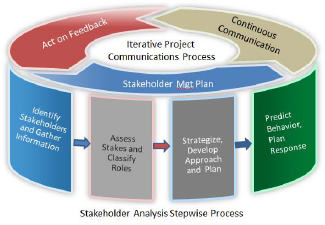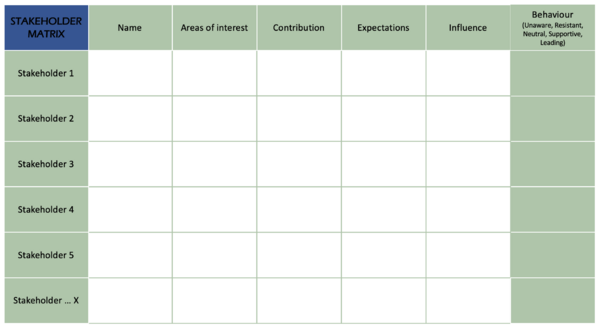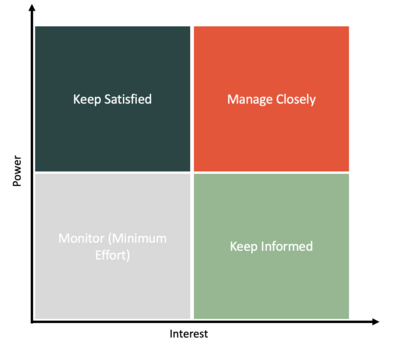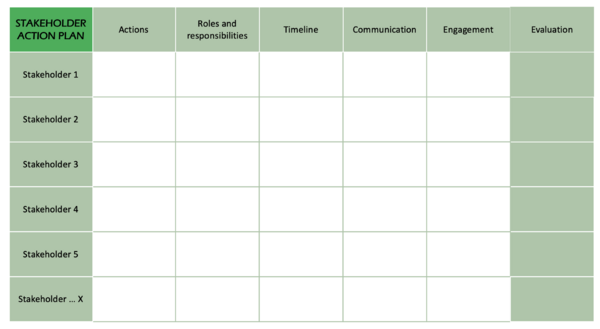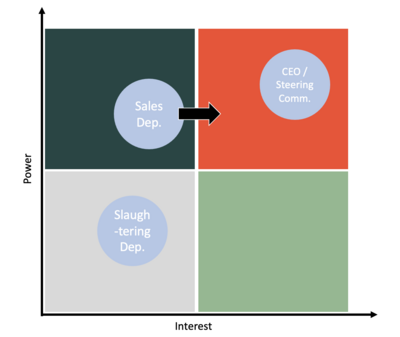Assessment of stakeholders (analysis)
Developed by Carl Bygum Knudsen
Contents |
Abstract
The assessment of stakeholders is a crucial element of any project or endeavour. It involves identifying, analyzing, and evaluating the stakeholders’ interests, potential, and influence to determine the best way to manage and interact with them. Stakeholder assessment, in essence, is the categorization and prioritisation of stakeholders in a way that clarifies how each individual stakeholder should be managed.
This wiki article provides a comprehensive overview of the assessment of stakeholders, including a discussion of the key steps involved, some of the tools and techniques used, and a company example. The critical steps of the assessment process will be discussed followed by the different tools and techniques used to assess stakeholders at each step. Stakeholder assessment is a broad subject and the article includes and briefly describes tools that assist the overall process of stakeholder analysis such as Stakeholder Mapping, Stakeholder Register, Power-Interest Grid and Stakeholder Action Plan. The wiki article will touch upon these subjects but focus on decision-making techniques such as the Power-Interest Grid, which allow for the assessment and prioritization of stakeholders.
Finally, the wiki article will outline some of the potential challenges and limitations associated with stakeholder assessment. These include the potential for conflict of interest, unequal access to resources, and lack of clear definitions. In general, this article provides a comprehensive overview for project managers to understand and implement the assessment of stakeholders and the key steps, tools and techniques involved.
Introduction
According to the PMI standard, "the purpose of stakeholder engagement is to enable the needs, interests and concerns of stakeholders to be identified, understood and addressed sufficiently to enable the objectives to be met "[1]. Stakeholder assessment is a part of the larger and more complex task of stakeholder engagement - and later management of those stakeholders. It is the initial process in stakeholder analysis of providing a clear understanding of stakeholders' interests and expectations. While stakeholder management is the overarching concept and the ongoing process of engaging and meeting the expectations of stakeholders, stakeholder assessment is increasingly focused on understanding the way a stakeholder may impact a project. To effectively deliver the outcomes of a project, a project manager needs to be capable of systematically gathering and analysing relevant information about the stakeholder in order to prioritize the various entities involved.
Stakeholder analysis is the art of knowing the stakeholders that will or can be impacted by the endeavours that you as a project manager strive to achieve. Getting the stakeholder management, and subsequently, the stakeholder assessment right in the first place is a vital cornerstone in any project and a key element towards project success. To gain a thorough understanding of stakeholder assessment, it is crucial to explain the steps of stakeholder assessment in detail [2].
Tags: Stakeholders, stakeholder assessment, stakeholder analysis, stakeholder management, stakeholder prioritisation, Power-Interest Grid, Salience Model, stakeholder mapping, stakeholder power, stakeholder influence, Project Management, Portfolio Management, Program Management
Stakeholder Assessment Process
Each step is outlined to give the reader a context, however, the actual stakeholder assessment primarily takes place in steps 3 & 4, as illustrated in Figure 1 or shown in the stakeholder management plan phase, step 2 & 3, of Figure 2. The tools connected to each step are merely suggestions and it is a non-exhaustive list of tools as stakeholder is a vast topic. The article will have a higher focus on the 3rd step and the tools that are relevant for this phase of stakeholder assessment, as it will be applied to a case company. It is relevant to note, that these steps recur in various other guides on stakeholder management and stakeholder analysis, and literature often uses these definitions interchangeably. In the section, "Tools & Techniques ", selected tools and techniques are presented to equip the project manager with the necessary knowledge to perform each step of the stakeholder assessment. In the following, two models shows classical ways of comprehenting stakeholder engagement and management processes [1] [3].
Identification: Brainstorm on and document stakeholders
Stakeholder identification is important for the success of any project, as it ensures that all individuals or groups affected by the project are identified and their needs and expectations are taken into account. This process is ongoing, iterative and requires effort to determine who will be impacted by the project, as well as to manage them throughout the project life cycle [3]. To start the identification process, one needs to review relevant project documents, organizational policies, and guidelines to identify stakeholders, who have various requirements that need to be taken into account. Brainstorming with a diverse group of individuals can be beneficial to identify essential stakeholders that are yet to be identified. A comprehensive stakeholder identification plan can be created using techniques such as stakeholder mapping, project charter, and stakeholder register, setting the project up for success [4].
Analysis: Categorize and analyze interests and potential
After stakeholders have been identified and brainstormed upon, it is crucial to classify and evaluate their interests and potential effects on the project. This entails reviewing how the project's objectives correspond with the expectations and concerns of the stakeholders. By obtaining this information a project manager may more easily comprehend their potential impact on the project and how to engage with them effectively. Use this step to find out what each stakeholder group's particular interests, demands, and expectations are. Surveys, interviews, focus groups, and one-on-one interactions are some tools that can be used to accomplish this. Take into account their goals for the project, their motives, and any potential conflicts of interest. Being able to clearly describe your project and the outcome of the project will improve the quality of this step [1] [5].
Prioritization: Evaluate stakeholder power and influence
After categorizing and analyzing the stakeholders, it is critical to assess their level of influence and prioritize them according to their importance to the project's success. Some stakeholders may wield more power than others, either because of their position within the organization or because of their level of interest in the project. Understanding the level of influence of stakeholders allows you to develop strategies for engaging with them effectively and managing their expectations. Ackermann and Eden find that the stakeholders with higher power, influence and interest have the biggest potential to assist with solving the problem [6]. While doing these exercises, it is a good idea to take into account elements like their power to make decisions, access to resources, knowledge, and degree of support or resistance to the initiative. Determine each stakeholder group's potential contribution to the project's success. Tools will be presented in the article that can help evaluate and assess how stakeholders can impact the project. A project manager should think about the ways that stakeholders can help the project achieve its goals, reduce its risks, or offer insightful information. This step might seem simple, but it has to be carefully considered, as "prioritizing stakeholders is more than a complex task of assessing the strength of their stake on the basis of economic or political power " [7].
Monitor Engagement: Plan, implement and communicate
The final step in the stakeholder assessment process is to develop a plan to engage with the stakeholders, implement the plan, and communicate with them throughout the project lifecycle. This involves developing communication strategies that are tailored to the needs and interests of each stakeholder group, and ensuring that key entities are informed of the project's progress and changes that could impact them.
By engaging with stakeholders throughout the project lifecycle, you can build trust and establish strong relationships that assist in making the project successful. This will ensure stakeholder buy-in and build the foundation for more successful projects. Monitoring stakeholder engagement is a reoccurring step, that will require you, as a project manager, to frequently check up on your stakeholders. Make sure that they are on board and following the project plan. Also, be proactive and investigate if there are any challenges on the horizon and how you might remediate those challenges. [5].
Tools and Techniques
Identifying the stakeholder: Stakeholder Mapping
Stakeholder mapping is very useful to project managers since it provides an easy way to understand the various perspectives and needs of stakeholders and to create communication and engagement strategies accordingly. It can also help identify potential risks or opportunities associated with stakeholders and guide decision-making throughout the project. Stakeholder mapping primarily involves the visual representation of the ecosystem or the environment that the project is done in, but secondly, it also hints at what kind of influence, power and interest the mapped stakeholders exercise. While there are several ways of visually representing the stakeholder environment as well as kick-starting the brainstorming session on stakeholders, a suggested tool for this phase is the Ecosystem Map.
The tool is developed by PROTEUS, a more detailed approach to traditional stakeholder mapping that is a useful tool for organisations to gain a better understanding of the complex relationships that exist in their operating environment. The mechanics is similar to the ones of the Social Network Diagram [8]. In short, to develop an Ecosystem Map, the scope and purpose of the map needs to be understood. The project manager needs to set boundaries and determine the level of detail and brainstorm on central stakeholders. These stakeholders a plotted on the map, whilst indicating flows of resources are connected between stakeholders to visualise the interdependency or lack thereof, between stakeholders [9].
Analyse and categorise the stakeholder: Stakeholder Matrix
This tool, often also referred to as stakeholder register or engagement matrix, takes the input gained from qualitative and quantitative methods such as interviews, surveys and other relevant data collection and documents it [5]. While there are various ways to collect stakeholder insights, a classical stakeholder analysis matrix is optimal to keep track of the knowledge obtained. The tool can be customised to fit the needs of the project manager depending on the wanted level of detail and type of categorization. It usually involves the name of the stakeholder, area of interest, contribution, expectations and influence. It may also be used in relation to stakeholder buy-in as a stakeholder engagement matrix, where the purpose of the tool is to determine whether the stakeholder is unaware, resistant, neutral, supportive, or leading. With this tool it is easier to prioritize and be proactive towards stakeholders [10]. The tool below is a mix of both the stakeholder register and the engagement matrix.
Prioritizing Stakeholders: Power-Interest Grid
The Power-Interest Grid is a tool used in stakeholder analysis to map stakeholders based on their level of power and interest in a project or organisation. It helps prioritize stakeholders and supports decision-making. The tool comes in various forms, such as Influence-Impact Grid or Influence-Interest Matrix designed to prioritize stakeholders, and the axes can be changed as the project manager desires. It helps to identify the stakeholders that require the most attention and prioritize the allocation of resources accordingly. The grid works as a grid with four quadrants, where stakeholders are plotted based on their level of power and interest relative to the project. The purpose of the Power-Interest Grid is to ensure that the identified stakeholders who are most interested in the project are kept informed and engaged throughout the process. Stakeholders in the "high-power/high-interest" quadrant should receive the most attention, followed by those in the "high-power/low-interest" quadrant, then those in the "low-power/high-interest" quadrant and finally "low-power/low-interest" quadrant should receive the least amount of attention. Irrespective of project size, is crucial for the success of the project that the relationships with powerful, influential, and interested stakeholders are managed properly [11] [12].
Monitoring: Stakeholder Action Plan
Collecting all of the input from the previous step is key to maintaining good stakeholder management. Developing a stakeholder action plan is a great tool to do so. It specifies the specific actions needed to move the project forward and ensures consistent engagement with stakeholders to address concerns and challenges that may arise. It outlines specific actions, responsibilities, and timelines for engaging with stakeholders. In simple terms, it can be viewed as a register of all the data obtained in the previous steps and the rough strategy to remediate any existing challenges. The plan should include a list of the stakeholders, a clear outline of roles and responsibilities, a timeline, communication and engagement strategies as well as space for evaluation and feedback to ensure continuous improvements [13] [14].
Company example and real-life application
Company example of stakeholder assessment, tool application and prioritization
The following section will showcase a company example and how the tools above, more specifically the Power-Interest Grid, contributed to stakeholder knowledge. The company analysis will be explained briefly to highlight the importance and benefits of the tools applied and act as a guideline to future project managers on how to gain stakeholder insights.
In a project conducted in the course 42433 - Advanced Engineering Project, Program and Portfolio Management at DTU in Spring 2023, a group worked with a global food company to increase stakeholder buy-in for a new strategy implementation project. This strategy had been devised in the operational department together with a consultancy company. Due to classified information and signed non-disclosure agreements the following analysis has been anonymised, the company will be referred to as Company A.
Company A
In this example, Company A had already completed the initial steps in the stakeholder assessment process. However, revisiting the prioritization of stakeholders allowed them to reevaluate their approach and improve how they engaged in issues related to stakeholders. This exercise also resulted in a more streamlined process for future projects. Initially, Company A created an organization diagram to gain an overview of relevant stakeholders related to the project. Specifically, the Sales Department's data input was crucial to optimize the forecasting of supply and demand, which was a major part and partial objective of the strategy.
Through interviews, Company A discovered a lack of buy-in from the Sales Department. By mapping the most important stakeholders, particularly in relation to gaining buy-in for the overall project, Company A was able to develop effective engagement strategies tailored to the Sales Department. This stakeholder mapping exercise provided a greater understanding of the problem.
The applied Power-Interest Grid (Figure 7) illustrates that the Slaughtering Department had low power and interest regarding this project aspect, making them not relevant in this context. The Sales Department, on the other hand, showed a low interest in data input, but had the primary control and power over the data collection process. This was a clear conflict of interest. Company A's top management department, illustrated with high power and high interest in the project, would typically be the main stakeholder to monitor from a classical perspective of the Power-Interest Grid. However, since they were already fully on board and motivated, they were not the primary focus for increasing stakeholder buy-in (as shown with the arrow).
In that discussion, it is important to note that the Power-Interest Grid has limitations, and the project manager must leverage its strengths. In hindsight, adopting a different approach, such as changing the axis to impact on the project and probability of impact, may have been beneficial. This approach would have made more sense for the ongoing supply and demand forecasting project, giving greater attention to the Sales Department from the beginning and potentially mitigating issues later on. However, such an adjustment would make it more challenging to create an overarching tool for stakeholder buy-in in future projects. Based on the analysis, increasing interest from the Sales Department was crucial, and the analysis served as a starting point for developing the necessary tools and strategies to enhance their engagement. Using the Power-Interest Grid and revisiting stakeholder prioritization allowed Company A to address the specific needs of the Sales Department and develop an effective engagement plan to cater for their needs.
Challenges and Limitations
Conflict of Interest
A significant challenge in stakeholder assessment is dealing with conflicts of interest. Stakeholders may have conflicting interests, either internally or externally, which can make it difficult for organizations to determine which stakeholder groups to prioritize. For example, a company may be faced with the competing interests of its shareholders, employees, and customers [7]. As Kujala et. al. puts it: "Conflict may arise from differing goals, expectations, or the clashing of cultural norms "[15]. To be prepared for this, it is essential to establish a just and transparent process for stakeholder engagement, where all stakeholders have an opportunity to express their concerns. Stakeholder assessment involves dealing with diverse interests and opinions, which can be challenging to manage. It is essential to ensure that all stakeholders are engaged in a meaningful and respectful way and that their concerns are taken seriously [15].
Unequal Access to Resources
Another significant challenge is the unequal access to resources. Different stakeholders may have different levels of access to information, resources, and decision-making processes. This can cause imbalances among the stakeholder and make it difficult for the project owner to meet stakeholder needs. The occurrence of stakeholder perception gaps can cause a mismatch of interests and values for stakeholder engagement. This is a threat to any project. It is essential to establish processes that enable all stakeholders to have somewhat equal access to resources. Furthermore, it is crucial to ensure that each stakeholder is engaged in a respectful way in order to manage diverse interests and opinions [15].
Clear definitions and structured planning
Decision-making based on clear definitions and sufficient available information is important for a project manager. Furthermore, it is important that all stakeholders - and especially the project team - are aligned on the objective. Kujala et. al.'s paper suggests that there is a need for a more detailed view of the negative impacts derived from stakeholder management and why they occur. The article differs between unintentional and intentional negative consequences in relation to the origin, aims, activities and impacts of projects. In relation to that, operating with unified and clear definitions is beneficial for stakeholder management as a whole [15]. Bendtsen et. al. backs this statement by identifying the lack of definitions of key concepts like "stakeholders" as well as the challenge of determining the individual power and influence of each stakeholder [16]. Furthermore, it is key to have a structured and systemic approach to stakeholder assessment, as it can cause major problems in projects to have a lack or weakness of structured planning as it affects all aspects of the project. This entails an effective way of identifying and communicating with stakeholders [14].
Conclusion
In conclusion, stakeholder assessment is a critical process that can significantly impact the success of any project or business strategy. Stakeholder engagement encompasses a wide range of factors, and it is crucial to carefully choose the tools and approaches that align with the specific objectives one aims to achieve. It should not be viewed as a strictly linear process, but rather as an iterative one that emphasizes the selection and application of appropriate tools and theories suitable for the situation. Through stakeholder analysis and evaluation, organizations can identify and prioritize stakeholders, understand their needs and interests, and develop strategies for effective engagement and management.
The key steps in the stakeholder assessment process can help any project be better suited at turning the project into a success. The process includes identifying stakeholders, analyzing their interests and potential, evaluating their power and influence and finally maintaining the achieved outcome through continuous stakeholder monitoring and engagement. The use of various tools and techniques such as stakeholder mapping, stakeholder and Power-Interest Grid can help to facilitate the assessment process. Achieving a favourable project outcome involves striking a balance among stakeholders' interests, recognizing their different types, and determining appropriate ways of interaction. It is also essential to be aware of the potential challenges and limitations associated with stakeholder assessment. While the tools and techniques in this field of project management are never-ending, the list of tools is a non-exhaustive one and the works presented here a merely a suggestion on how to navigate the vast topic of stakeholder assessment.
To summarise, stakeholder assessment is an important process that revolves around the identification, interpretation, prioritisation and implementation of knowledge and learnings in relation to the stakeholders of a project. It can contribute significantly to the success of projects and strategies. Mastering the art of stakeholder assessment allows the project manager to execute the endeavour successfully and thereby obtain the desired outcomes of a project, portfolio or programme.
Bibliography
Guide to the Project Management Body of Knowledge (PMBOK® Guide) (7th Edition)
The PMBOK Guide has been used to obtain a clear overview of the stakeholder engagement process. The guide offers a comprehensive overview of stakeholder analysis and its impact on project management, which has been useful since stakeholder management is a vast topic. It provides valuable insights into developing effective management strategies to engage stakeholders in project decisions and execution. The book made for an ideal starting point for gaining a broader understanding of the topic discussed in this article.
Article: "Got stake?: (Holder) management in your project"
The article on stakeholder management provides an easy-to-use and applicable guide on the key factors that are crucial to perform stakeholder management. The article by Forman and Discenza supported the selection process of choosing the best tools to clearly and briefly encapsulate the major topic of stakeholder assessment.
Article: "Stakeholder Engagement: Past, Present, and Future"
The paper on engagement helped the overall process, but specifically looked into the challenges and risks of stakeholder management malpractice. Specifically underlining that insufficient communication and management of stakeholder needs lead to negative impacts, which highlights the importance of the overall topic of stakeholder assessment. In the article, a table describes the common mistakes and challenges of stakeholder assessment and engagement.
References
- ↑ 1.0 1.1 1.2 Project Management Institute, Inc.. (2021). Guide to the Project Management Body of Knowledge (PMBOK® Guide) (7th Edition). Project Management Institute, Inc. (PMI). Retrieved from https://app-knovel-com.proxy.findit.cvt.dk/kn/resources/kpSPMAGPMP/toc
- ↑ Müller, Ralf & Jugdev, Kam. (2012). Critical success factors in projects: Pinto, Slevin, and Prescott – the elucidation of project success. International Journal of Managing Projects in Business. 5. 757-775. 10.1108/17538371211269040.
- ↑ 3.0 3.1 Brian Irwin PMP, M. S. M. Managing politics and conflict in projects. Berrett-Koehler Publishers, 2008.
- ↑ Smith, L. W. (2000). Stakeholder analysis: a pivotal practice of successful projects. Paper presented at Project Management Institute Annual Seminars & Symposium, Houston, TX. Newtown Square, PA: Project Management Institute.
- ↑ 5.0 5.1 5.2 Forman, J. B. & Discenza, R. (2012). Got stake?: (Holder) management in your project. Paper presented at PMI® Global Congress 2012—North America, Vancouver, British Columbia, Canada. Newtown Square, PA: Project Management Institute. PMI.org: https://www.pmi.org/learning/library/stakeholder-management-plan-6090
- ↑ Fran Ackermann, Colin Eden, Strategic Management of Stakeholders: Theory and Practice, Long Range Planning, Volume 44, Issue 3, 2011, Pages 179-196, ISSN 0024-6301, https://doi.org/10.1016/j.lrp.2010.08.001.
- ↑ 7.0 7.1 Freeman, R. & Mcvea, John. (2001). A Stakeholder Approach to Strategic Management. SSRN Electronic Journal. 10.2139/ssrn.263511.
- ↑ Baker, E. (2012). Planning effective stakeholder management strategies to do the same thing! Paper presented at PMI® Global Congress 2012—North America, Vancouver, British Columbia, Canada. Newtown Square, PA: Project Management Institute.
- ↑ McAloone, T. (2014). Proteus Workbook. https://proteus.dtu.dk. https://proteus.dtu.dk/results/workbooks/wb4
- ↑ Sebastian. (2021). Stakeholder engagement assessment matrix: Uses & example [PMP®-relevant]. Project. https://project-management.info/stakeholder-engagement-matrix/
- ↑ Mendelow, A. L.. “Environmental Scanning-The Impact of the Stakeholder Concept.” International Conference on Interaction Sciences (1981).
- ↑ Stakeholder Analysis - Winning Support for Your Projects. (n.d.). Retrieved May 9, 2023, from https://www.mindtools.com/aol0rms/stakeholder-analysis (1981).
- ↑ Stakeholder Management Plan Template | Pmitools. (n.d.). Retrieved May 9, 2023, from https://pmitools.net/stakeholder-template/stakeholder-management-plan-template/
- ↑ 14.0 14.1 Ibraheem, Israa. (2018). The effects of stakeholder’s engagement and communication management on projects success. MATEC Web of Conferences. 162. 02037. 10.1051/matecconf/201816202037.
- ↑ 15.0 15.1 15.2 15.3 Kujala, J., Sachs, S., Leinonen, H., Heikkinen, A., & Laude, D. (2022). Stakeholder Engagement: Past, Present, and Future. Business & Society, 61(5), 1136–1196. https://doi.org/10.1177/00076503211066595
- ↑ Bendtsen, E. B., Clausen, L. P. W., & Hansen, S. F. (2021). A review of the state-of-the-art for stakeholder analysis with regard to environmental management and regulation. Journal of Environmental Management, 279.

